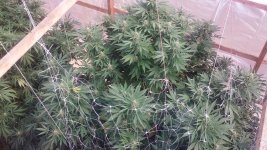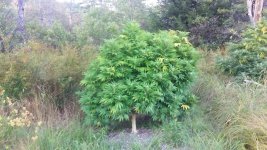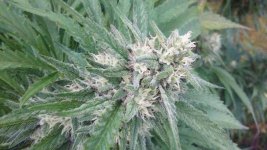So I am having some botrytis problems this year as many in my location do. More so in the GH then in my woods plots for obvious humidity/lack of natural breeze reasons. The rain has been holding out so far but I'm sure once they come I will be having problems in the woods too.
The best approach is definitely prevention with a proper IPM but Botrytis cinerea is a very worthy opponent and sometimes people make mistakes or the weather screws you...
I think the general consensus has been once botrytis hits chop the affected buds (which can cause big bud loses) and also harvest early (inferior product). I have heard "better early bud than no bud" many times. I think it doesn't have to be this way
I am running a different approach this year as all available fungicides and infected bud removal has not been making a noticeable difference.
Here is my plan:
1-A rotating plan of fungicides have been sprayed as long into flower as I feel comfortable (actinovate, serenade, greencure)
2-environmental controls the best they can be
3-Remove only heavily infected buds
4-Keep a close eye the progression of the Botrytis as well as bud "ripeness"
5-Harvest as soon as you choose (not desperation chop)
6-Harvest/rough trim while separating affected buds from unaffcted buds.
7-Hang unaffected buds to dry/cure (away from any Botrytis)
8- Remove what you can of the Botrytis from the affected buds and put them directly into a deep freezer as soon as you can after harvest
9-Blast (BHO) Fresh Frozen buds. Then redissolve concentrate into 190 proof ethanol and filter through 30 micron filter. (instruction can be found online from Greywolf)
With this system I hope to get AT LEAST 50% well ripened flowers and the rest will not be wasted and should give me a very nice concentrate product
Any thoughts guys?
The best approach is definitely prevention with a proper IPM but Botrytis cinerea is a very worthy opponent and sometimes people make mistakes or the weather screws you...
I think the general consensus has been once botrytis hits chop the affected buds (which can cause big bud loses) and also harvest early (inferior product). I have heard "better early bud than no bud" many times. I think it doesn't have to be this way
I am running a different approach this year as all available fungicides and infected bud removal has not been making a noticeable difference.
Here is my plan:
1-A rotating plan of fungicides have been sprayed as long into flower as I feel comfortable (actinovate, serenade, greencure)
2-environmental controls the best they can be
3-Remove only heavily infected buds
4-Keep a close eye the progression of the Botrytis as well as bud "ripeness"
5-Harvest as soon as you choose (not desperation chop)
6-Harvest/rough trim while separating affected buds from unaffcted buds.
7-Hang unaffected buds to dry/cure (away from any Botrytis)
8- Remove what you can of the Botrytis from the affected buds and put them directly into a deep freezer as soon as you can after harvest
9-Blast (BHO) Fresh Frozen buds. Then redissolve concentrate into 190 proof ethanol and filter through 30 micron filter. (instruction can be found online from Greywolf)
With this system I hope to get AT LEAST 50% well ripened flowers and the rest will not be wasted and should give me a very nice concentrate product
Any thoughts guys?







 have u ever tried kali mist outdoors?
have u ever tried kali mist outdoors?
